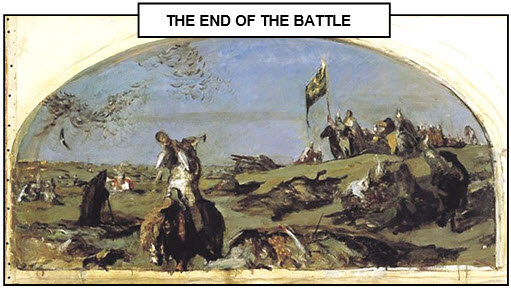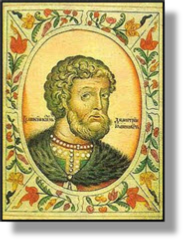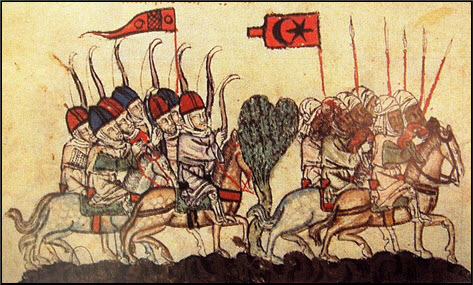


RUSSIA -
Including:
Dmitry
Donskoy

xxxxxAs we have seen, by 1241 (H3) the Mongol leader Batu had advanced deep into Eastern Europe, posing a serious threat to the continent, but, with the death of the Mongol Emperor, he abandoned his campaign and returned to southern Russia. There he established a vast army known as the Golden Horde. Over the next hundred years this force extended its control over most of European Russia, but, following the ravages of the Black Death in 1346, a power struggle broke out. An alliance of local Russian princes was formed, and in 1380, somewhat surprisingly, it won a resounding victory over the powerful Golden Horde at the Battle of Kulikovo. The Russian success was short-
xxxxxAs we have seen, by 1241 in the reign of Henry III, the Mongol leader Batu, grandson of Ghengis Khan, had ventured into Europe. By 1241 he had conquered western Russia, including the cities of Kiev and Moscow, and advanced into Poland, Hungary and the Danube valley, burning, pillaging and killing as he went. The western states of Europe were ill-
 xxxxxBatu died in about 1255. Over the next hundred years his successors continued to expand the Horde’s territory. At its height it included much of European Russia, and stretched from the Black Sea and the Caucasus Mountains in the south-
xxxxxBatu died in about 1255. Over the next hundred years his successors continued to expand the Horde’s territory. At its height it included much of European Russia, and stretched from the Black Sea and the Caucasus Mountains in the south-
xxxxxThe man who achieved this remarkable victory at Kulikovo was the prince of Moscow, Dmitry (II) Donskoy. Having formed an alliance of local princes he stopped making tribute payments to the Mongols and when they sent in an army to collect their dues, he led a force against them. Both sides met at Kulikovo Pole on the River Don, and the Russians, due to the military skill of their leader, won the day. For his services, Ivanovich was honoured with the title Donskoy (“of the Don”). However, the triumph was short-
 xxxxxThe man who won this remarkable victory at Kulikovo was Dmitry (II) Donskoy, Grand Prince of Moscow from 1359 to his death in 1389. He formed an alliance of local princes and stopped making his tribute payments to his Mongol masters. Mamai, the general ruling over the western section of the Horde, promptly invaded the Russian lands to sort the matter out. Normally, any resistance would have been ineffective. On this occasion, however, a Russian force under the leadership of Dmitry, met the Mongols face on at Kulikovo Pole (Snipes’ Field) on the River Don. In the bloody battle which ensued, the Russians won a resounding victory. At the height of the conflict Dmitry sent in a body of reserves, and the Horde gave way and fled. It was a victory to be savoured, and the Russians honoured the Prince of Moscow by giving him the name Donskoy -
xxxxxThe man who won this remarkable victory at Kulikovo was Dmitry (II) Donskoy, Grand Prince of Moscow from 1359 to his death in 1389. He formed an alliance of local princes and stopped making his tribute payments to his Mongol masters. Mamai, the general ruling over the western section of the Horde, promptly invaded the Russian lands to sort the matter out. Normally, any resistance would have been ineffective. On this occasion, however, a Russian force under the leadership of Dmitry, met the Mongols face on at Kulikovo Pole (Snipes’ Field) on the River Don. In the bloody battle which ensued, the Russians won a resounding victory. At the height of the conflict Dmitry sent in a body of reserves, and the Horde gave way and fled. It was a victory to be savoured, and the Russians honoured the Prince of Moscow by giving him the name Donskoy -
xxxxxUnfortunately for the Russians, their triumph was short- number of small Khanates, the most important being Astrakhan, Kazan, Sibir and the Crimea. The Russians, the ultimate victors, conquered the first three in the sixteenth century, whilst the Crimea became a vassal state of the new giant on the world stage, the Ottoman Empire. As we shall see, the rise of Russia was to begin in
number of small Khanates, the most important being Astrakhan, Kazan, Sibir and the Crimea. The Russians, the ultimate victors, conquered the first three in the sixteenth century, whilst the Crimea became a vassal state of the new giant on the world stage, the Ottoman Empire. As we shall see, the rise of Russia was to begin in
xxxxxWith the advantage of hindsight, it may well be that the Golden Horde made a serious mistake in turning their back on Western Europe. This area would certainly have provided better pickings than the deserts of Turkestan or the wastelands of Siberia. Furthermore, by so doing, they allowed the Russian princes to become more independent and to grow in strength and daring. It was they, in the end, who devoured most of what was left of the Horde when it broke into pieces. Certainly, history would have been very different had the Mongols swept into western Europe in the fourteenth century like the Huns had done before them in the fourth and fifth.
xxxxxIncidentally, the description “Golden” is said by some sources to derive from the bright colour of the tents used by the Tatars. Others, however, suggest that it refers to Batu’s own tent which, we are told, was made out of silk and beautifully embroidered in bright colours. You may take your pick, but probably the second explanation is the more likely!
Acknowledgements
After the Battle: by the Russian impressionist painter Valentin Serov (1865-
R2-


